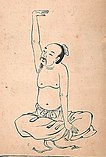Meditacija
Meditacija je smireno stanje organizma sa glavnim ciljem umirivanja i opuštanja uma ili tzv. „nerazmišljanja“. U religiji, posebno u drevnim religijama Istoka, duhovna disciplina i veština koncentracije na unutrašnja, mentalna stanja, na izazivanje vizija, prosvetljenja i mističnog doživljaja stapanja sa Bogom ili onostranim svetom. Kao tehnika psihološke relaksacije meditacija se praktikuje u okviru različitih mentalno-higijenskih programa koji su usmereni ka neutralizaciji posledica stresnog života savremenog čoveka. Najpoznatiji oblik meditacije je joga. Reč meditacija dolazi od latinske reči meditatio, što je označavalo bilo koju vrstu fizičke i intelektualne vežbe, a kasnije je za tu vrstu prakse počeo da se upotrebljava termin kontemplacija.

Meditacija je praksa u kojoj pojedinac koristi tehniku - kao što je svesnost, ili fokusiranje uma na određeni predmet, misao ili aktivnost - za obučavanje pažnje i svesti, i postizanje mentalno jasnog i emocionalno mirnog i stabilnog stanja.[1]:228–29[2]:180[3]:415[4]:107[5][6] Naučnici su ustanovili da je meditaciju teško definisati, jer se prakse razlikuju i između tradicija i unutar njih.
Meditacija se praktikuje u brojnim religijskim tradicijama. Najraniji zapisi o meditaciji (džijana) nalaze se u drevnim hinduističkim tekstovima poznatim kao Vede, i meditacija igra istaknutu ulogu u kontemplativnom repertoaru hinduizma i budizma.[7] Od 19. veka, azijske meditativne tehnike proširile su se i na druge kulture gde su takođe pronašle primenu u neduhovnim kontekstima, kao što su posao i zdravlje.
Meditacija može značajno smanjiti stres, anksioznost, depresiju i bol[8] i poboljšati mir, percepciju,[9] samopoimanje i blagostanje.[10][11][12][13] U toku su istraživanja kako bi se bolje razumeli efekti meditacije na zdravlje (psihološko, neurološko i kardiovaskularno) i druga područja.
Meditacija u savremenoj psihologiji
urediU savremenoj psihologiji pojam meditacija ima značenje posebnog postupka ili tehnike kojom se dolazi do izmenjenog stanja svesti. U okviru joge i zen-budizma nastali su različiti postupci meditacije, povezani sa određenim filozofskim i religioznim gledištima. Jedan od najrasprostranjenijih oblika meditacije je transcendentalna meditacija. Reč je o obliku joga-meditacije prilagođene shvatanjima, karakteru i navikama čoveka zapadne civilizacije. Transcendentalna meditacija ne pretpostavlja nikakvo filozofsko ili religiozno uverenje i uči se veoma brzo. Postupak transcendentalne meditacije u knjigama nije detaljno opisan jer podrazumeva da se on mora naučiti usmeno od učitelja. U glavnim crtama se sastoji u konstantnom ponavljanju mantre i usmerenosti celokupne pažnje na nju. Meditacijom na ovaj način se dovodi u stanje prazne ili čiste svesti, svesti bez konkretnih sadržaja. To stanje prazne svesti je stanje bez uznemirujućih misli zbog čega je moguće psihičko opuštanje i spokojstvo. Istraživanja su pokazala da se u toku transcendentalne meditacije organizam zaista duboko odmara. Mišići su opušteni, puls umiren, krvni pritisak spušten, bazalni metabolizam manji nego u snu i slično.
Meditacije moći
urediPod ovu vrstu meditacije spadaju meditacije za otvaranje čakri, kundalini energiju i slično.
Neke od poznatijih verskih grupacija koji praktikuju ovakve meditacije su Hinduisti[14] i Spiritualni Satanisti.[15] Prema verovanjima Spiritualnih Satanista, tehnike i znanja o ovakvim meditacijama su čovečanstvu data direktno od Demona, koje oni nazivaju originalnim paganskim Bogovima.[16]
Reference
uredi- ^ Walsh, Roger; Shapiro, Shauna L. (2006). „The meeting of meditative disciplines and western psychology: A mutually enriching dialogue”. American Psychologist. 61 (3): 227—239. PMID 16594839. S2CID 3015768. doi:10.1037/0003-066X.61.3.227.
- ^ Cahn, B. Rael; Polich, John (2006). „Meditation states and traits: EEG, ERP, and neuroimaging studies”. Psychological Bulletin. 132 (2): 180—211. PMID 16536641. S2CID 2151810. doi:10.1037/0033-2909.132.2.180.
- ^ Jevning, R.; Wallace, R.K.; Beidebach, M. (septembar 1992). „The physiology of meditation: A review. A wakeful hypometabolic integrated response”. Neuroscience & Biobehavioral Reviews. 16 (3): 415—424. PMID 1528528. S2CID 2650109. doi:10.1016/s0149-7634(05)80210-6.
- ^ Goleman, Daniel (1988). The meditative mind: The varieties of meditative experience. New York: Tarcher. ISBN 978-0-87477-833-5.
- ^ „Definition of meditate”. Merriam-Webster Dictionary. 18. 12. 2017. Pristupljeno 25. 12. 2017.
- ^ „meditate”. Oxford Dictionaries – English. Arhivirano iz originala 29. 05. 2019. g. Pristupljeno 08. 08. 2021.
- ^ Dhavamony, Mariasusai (1982). Classical Hinduism (na jeziku: engleski). Università Gregoriana Editrice. str. 243. ISBN 978-88-7652-482-0.
- ^ Hölzel, Britta K.; Lazar, Sara W.; Gard, Tim; Schuman-Olivier, Zev; Vago, David R.; Ott, Ulrich (novembar 2011). „How Does Mindfulness Meditation Work? Proposing Mechanisms of Action From a Conceptual and Neural Perspective”. Perspectives on Psychological Science: A Journal of the Association for Psychological Science. 6 (6): 537—559. ISSN 1745-6916. PMID 26168376. S2CID 2218023. doi:10.1177/1745691611419671.
- ^ „The Dalai Lama explains how to practice meditation properly”. 3. 5. 2017.
- ^ „Meditation: In Depth”. NCCIH.
- ^ Goyal, M.; Singh, S.; Sibinga, E. M.; Gould, N. F.; Rowland-Seymour, A.; Sharma, R.; Berger, Z.; Sleicher, D.; Maron, D. D.; Shihab, H. M.; Ranasinghe, P. D.; Linn, S.; Saha, S.; Bass, E. B.; Haythornthwaite, J. A. (2014). „Meditation Programs for Psychological Stress and Well-being: A Systematic Review and Meta-analysis”. JAMA Internal Medicine. 174 (3): 357—368. PMC 4142584 . PMID 24395196. doi:10.1001/jamainternmed.2013.13018.
- ^ Shaner, Lynne; Kelly, Lisa; Rockwell, Donna; Curtis, Devorah (2016). „Calm Abiding”. Journal of Humanistic Psychology. 57: 98. S2CID 148410605. doi:10.1177/0022167815594556.
- ^ Campos, Daniel; Cebolla, Ausiàs; Quero, Soledad; Bretón-López, Juana; Botella, Cristina; Soler, Joaquim; García-Campayo, Javier; Demarzo, Marcelo; Baños, Rosa María (2016). „Meditation and happiness: Mindfulness and self-compassion may mediate the meditation–happiness relationship” (PDF). Personality and Individual Differences. 93: 80—85. doi:10.1016/j.paid.2015.08.040. hdl:10234/157867 .[mrtva veza]
- ^ https://www.encyclopedia.com/philosophy-and-religion/eastern-religions/hinduism/kundalini. Nedostaje ili je prazan parametar
|title=(pomoć) - ^ „Important Information Concerning Power Meditation”.
- ^ „Energy of the Soul”.
Literatura
uredi- Ovaj članak ili njegov deo izvorno je preuzet iz Rečnika socijalnog rada Ivana Vidanovića uz odobrenje autora.
- Kreč, D. i Kračfild, R. (1978): Elementi psihologije, Beograd, Naučna knjiga
- Austin, James H (1999). Zen and the Brain: Toward an Understanding of Meditation and Consciousness. Cambridge: MIT Press. ISBN 0-262-51109-6., 1999,
- Azeemi, Khwaja Shamsuddin Azeemi (2005). Muraqaba: The Art and Science of Sufi Meditation. Houston: Plato. ISBN 0-9758875-4-8., 2005,
- Bennett-Goleman, T (2001). Emotional Alchemy: How the Mind Can Heal the Heart,. Harmony Books. ISBN 0-609-60752-9.,
- Benson, Herbert and Miriam Z. Klipper. (2000 [1972]). The Relaxation Response. Expanded Updated edition. Harper. ISBN 0-380-81595-8
- Bond, Kenneth; Ospina, Maria B.; Hooton, Nicola; Bialy, Liza; Dryden, Donna M.; Buscemi, Nina; Shannahoff-Khalsa, David; Dusek, Jeffrey; Carlson, Linda E. (2009). „Defining a complex intervention: The development of demarcation criteria for 'meditation'”. Psychology of Religion and Spirituality. 1 (2): 129—137. doi:10.1037/a0015736. (NB: Bond, Ospina et al., 2009, has substantial overlap with the full report by Ospina, Bond et al., 2007, listed below. Overlap includes the first 6 authors of this paper, and the equivalence of Table 3 on p. 134 in this paper with Table B1 on p. 281 in the full report)
- Craven, John L. (oktobar 1989). „Meditation and Psychotherapy *”. The Canadian Journal of Psychiatry. 34 (7): 648—653. PMID 2680046. S2CID 27930160. doi:10.1177/070674378903400705.
- Goleman, Daniel (1988). The meditative mind: The varieties of meditative experience. New York: Tarcher. ISBN 978-0-87477-833-5.
- Hayes, S. C.; Strosahl, K. D.; Wilson, K. G. (1999) Acceptance and Commitment Therapy. New York: Guilford Press.
- Kutz, I; Borysenko, JZ; Benson, H (januar 1985). „Meditation and psychotherapy: a rationale for the integration of dynamic psychotherapy, the relaxation response, and mindfulness meditation”. American Journal of Psychiatry. 142 (1): 1—8. PMID 3881049. doi:10.1176/ajp.142.1.1.
- Lutz, A.; Greischar, L. L.; Rawlings, N. B.; Ricard, M.; Davidson, R. J. (16. 11. 2004). „Long-term meditators self-induce high-amplitude gamma synchrony during mental practice”. Proceedings of the National Academy of Sciences. 101 (46): 16369—16373. Bibcode:2004PNAS..10116369L. PMC 526201 . PMID 15534199. doi:10.1073/pnas.0407401101 .
- Metzner, R. (2005) Psychedelic, Psychoactive and Addictive Drugs and States of Consciousness. In Mind-Altering Drugs: The Science of Subjective Experience, Chap. 2. Mitch Earlywine, ed. Oxford University Press.
- MirAhmadi, As Sayed Nurjan (2005). Healing Power of Sufi Meditation. Islamic Supreme Council of America.
- Nirmalananda Giri, Swami (2007) Om Yoga: Its Theory and Practice In-depth study of the classical meditation method of the Bhagavad Gita, Yoga Sutras of Patanjali, and the Upanishads.
- Ospina, MB; Bond, K; Karkhaneh, M; Tjosvold, L; Vandermeer, B; Liang, Y; Bialy, L; Hooton, N; Buscemi, N; Dryden, DM; Klassen, TP (jun 2007). „Meditation practices for health: state of the research”. Evidence Report/Technology Assessment (155): 1—263. PMC 4780968 . PMID 17764203.
- Perez-De-Albeniz, Alberto; Holmes, Jeremy (2000). „Meditation: Concepts, Effects And Uses In Therapy”. International Journal of Psychotherapy. 5 (1): 49—58. doi:10.1080/13569080050020263.
- Shalif, Ilan et al. (1989) Focusing on the Emotions of Daily Life (Tel-Aviv: Etext Archives, 2008)
- Shapiro, D. H. (1982). „Overview: Clinical and physiological comparison of meditation with other self-control strategies”. American Journal of Psychiatry. 139 (3): 267—74. PMID 7036760. doi:10.1176/ajp.139.3.267.; Reprinted as chapter 1 (pp. 5–10) in. Shapiro, Deane H.; Walsh, Roger N. (1984). Meditation, classic and contemporary perspectives. New York: Aldine. ISBN 978-0-202-25136-3. (the book was republished in 2008: ISBN 978-0-202-36244-1)
- Shapiro, Deane H. (1992). „Adverse effects of meditation: a preliminary investigation of long-term meditators”. International Journal of Psychosomatics. 39 (1–4): 62—7. PMID 1428622. S2CID 52203383.
- Shear, Jonathan, ur. (2006). The experience of meditation: Experts introduce the major traditions. St. Paul, MN: Paragon House. ISBN 978-1-55778-857-3.
- Sogyal Rinpoche. The Tibetan Book of Living and Dying. ISBN 0-06-250834-2.,
- Smith, Fritz Frederick (1986). Inner Bridges: A Guide to Energy Movement and Body Structure. ISBN 978-0-89334-086-5., Humanics Ltd. Partners, .
- Tart, Charles T., editor (1969). Altered States of Consciousness. ISBN 0-471-84560-4. .
- Trungpa, C. (1973) Cutting Through Spiritual Materialism, Shambhala South Asia Editions, Boston, Massachusetts.
- Trungpa, C. (1984) Shambhala: The Sacred Path of the Warrior, Shambhala Dragon Editions, Boston, Massachusetts.
- Erhard Vogel (2001). Journey Into Your Center. Nataraja Publications. ISBN 1-892484-05-6.,
- Wenner, Melinda. "Brain Scans Reveal Why Meditation Works." LiveScience.com. 30 June 2007.
- Ajahn Brahm (2006). Mindfulness Bliss and Beyond. ISBN 978-0-86171-275-5.
- Meditation & The References From Various Religions – What is Meditation.
- Baba, Meher (1995). Discourses. Myrtle Beach, SC: Sheriar Foundation. ISBN 978-1-880619-09-4.
- Cooper, David. A. The Art of Meditation: A Complete Guide. ISBN 81-7992-164-6.
- Easwaran, Eknath. Meditation. ISBN 0-915132-66-4. (see article). new edition: Passage Meditation. ISBN 978-1-58638-026-7. The Mantram Handbook ISBN 978-1-58638-028-1
- Glickman, Marshall (2002). Beyond the Breath: Extraordinary Mindfulness Through Whole-Body Vipassana. ISBN 1-58290-043-4 * Goenka, S. N.. line feed character u
|title=na poziciji 175 (pomoć)Meditation Now: Inner Peace through Inner Wisdom, ISBN 1-928706-23-1 - Hanson, Rick; Mendius, Richard (2009). Buddha's Brain: The Practical Neuroscience of Happiness, Love, and Wisdom. New Harbinger Publications. ISBN 978-1-57224-695-9.
- Hart, William (1987). Art of Living, Vipassana Meditation. ISBN 978-0-06-063724-8.,
- Krishnamurti, Jiddu (1999). This Light in Oneself: True Meditation. ISBN 1-57062-442-9., Shambhala Publications.
- Heller, Rick (2015). Secular Meditation: 32 Practices for Cultivating Inner Peace, Compassion, and Joy – A Guide from the Humanist Community at Harvard. ISBN 978-1-60868-369-7., New World Library.
- Levin, Michal. Meditation, Path to the Deepest Self. ISBN 978-0-7894-8333-1., Dorling Kindersley, 2002.
- Long, Barry (1995). Meditation: A Foundation Course – A Book of Ten Lessons. ISBN 1-899324-00-3.
- Meditation for Beginners without Religion – Meditation for Beginners.
- Meiche, Michele. Meditation for Everyday Living. ISBN 0-9710374-6-9.
- Monaghan, Patricia and Eleanor G. Viereck (1999). Meditation: The Complete Guide. ISBN 1-57731-088-8.
- Oldstone-Moore, Jennifer. Understanding Confucianism. ISBN 1-904292-12-7., Duncan Baird, 2003.
- Saraydarian, Torkom (1976). The Science of Meditation. TSG Publishing Foundation. ISBN 978-0-911794-29-8.
- Shankarananda, Swami (2004). Happy For No Good Reason. Shaktipat Press. ISBN 978-0-9750995-1-3..
- Vethathiri Maharishi. Yoga for Modern life.
- Wood, Ernest. Concentration – An Approach to Meditation. ISBN 0-8356-0176-5. Arhivirano iz originala 09. 06. 2021. g. Pristupljeno 08. 08. 2021. Theosophical Publishing House 1949.
- Yogananda, Paramahansa. Autobiography of a Yogi.
Spoljašnje veze
uredi- Vrste i smisao meditacije
- Vodič kroz Meditaciju
- Meditation na sajtu Curlie (jezik: engleski)
- Meditation at Encyclopædia Britannica





